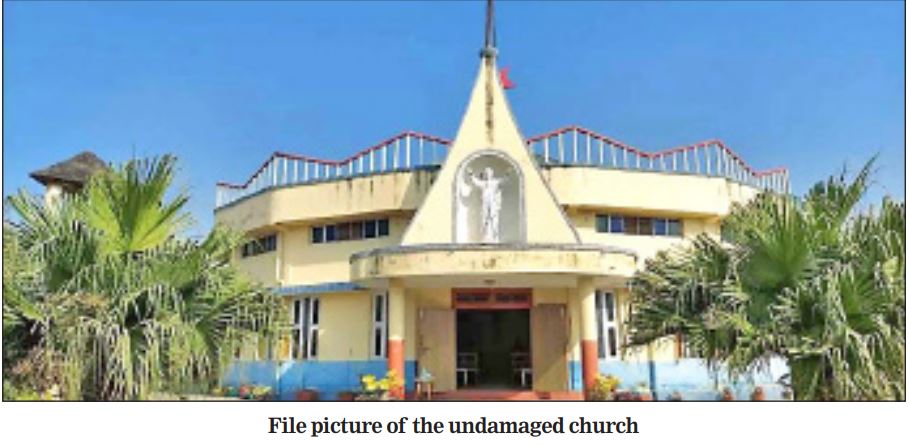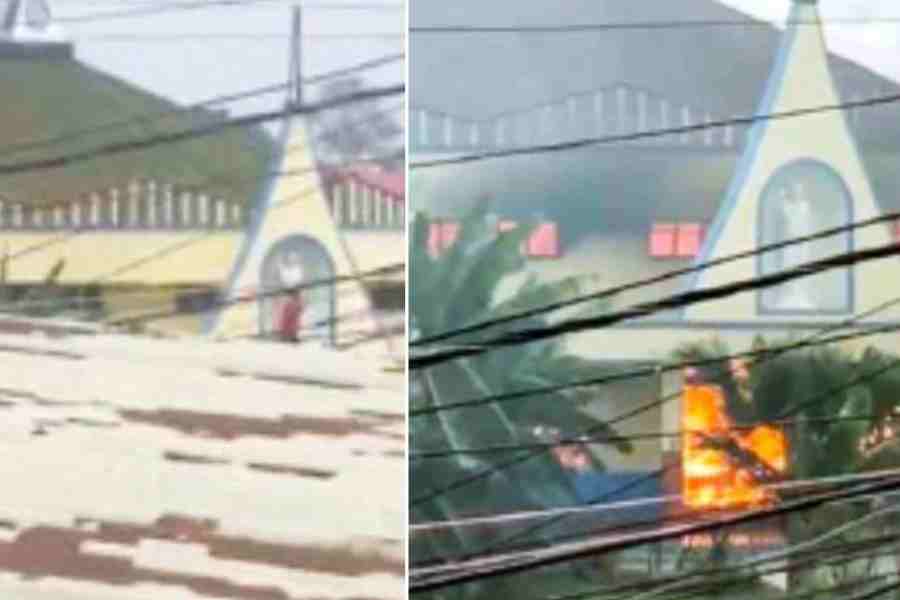THUD!
The attacker pauses for taking fresh aim.
THUD!
The target of the missiles is still standing.
Then someone passes on from down below something that resembles an iron rod.
The rod swings and makes contact.
THWACK! THWACK! THWACK! THWACK! THWACK! THWACK! THWACK! THWACK! THWACK! THWACK!
The first few blows are aimed at the midriff. The others are delivered on the left shoulder.
On the 10th blow, the left hand comes loose and falls off.
A roar rises from below, emitted in triumph by the unseen crowd.
Then the demolisher in a red T-shirt goes to work on the right hand.
Rising smoke darkens the backdrop. The sound of the fire crackling and advancing is unmistakable.
The place: Sangaiprou in Imphal West district, Manipur. Not more than 3.5km from the airport.
The time and date: Around 1.30pm to 2pm, May 4, when the clashes peaked in Manipur.
The structure: St. Paul’s Church.
The target: The statue of the Resurrected Jesus Christ in the niche of the spire.
The deliberate and unhurried pace — that hangs heavy long after the two video clips had been viewed.
This is no flare-up or riot that erupted in the heat of the moment. This is not the unquiet memory of decades of ethnic tension exploding when passions are set aflame.
The vandalism and arson sound and look more like the “lit match” that Arundhati Roy had cautioned the Church about a few days ago. A “lit match” that was thrown with precision and impunity at the firewood in Manipur.
The demolition attempt described at the top is sourced from one of the two video clips that have been doing the rounds on social media for some days.
Some social media users had wrongly identified the Catholic church that was set on fire. Eventually, The Telegraph tracked down a person from the vicinity who identified the church and shared “painful” details of the destruction. The person, who left Manipur last week, was 300 metres away from the church on May 4 and could see the smoke, this newspaper was told.
The raw scenes were filmed by someone who appeared to have been hiding on the roof of the nearby building, often ducking, possibly to evade attention and certain harm.
As scorching as the crimson flames is the cocksure manner in which the youth in the red T-shirt goes about vandalising the statue of the Resurrected Christ.
The single-minded application of mind and muscle, the complete lack of concern at the possibility of being challenged or apprehended and the apparent absence of any security personnel bring under stress theories some BJP-friendly church groups have been spreading.
There is no suggestion that the BJP was involved in the church attack. But Manipur is governed by the BJP and curfew was supposed to have been in place. The church is not in a far-flung area but less than 3.5km from the Imphal airport. The affected still ask about the security arrangements that had supposedly been put in place because the attackers struck with “impunity” in the state capital, that too “during curfew hours”.
If the video clip suggests a deliberate and calculated attack, so do accounts by at least two people who were in the vicinity.
One of them said the attackers had “visited” the church several times, starting from May 3. Initially, they had vandalised parts of the church and the Pastoral Training Centre behind it on the night of May 3 and left, before launching the full-fledged assault on May 4 afternoon.
The flashpoint for the Manipur clashes was concerns among the tribal populace, including the minority Kuki and Naga communities, about the possibility of the majority Meiteis being granted the Scheduled Tribe status and its attendant protection and benefits.

The Supreme Court has since then intervened and cautioned against any unilateral step.
The unrest has taken a heavy toll on life and property — at least 74 people dead, close to 1,700 houses destroyed and about 45,000 affected. Both Kukis — mostly Christians — and Meiteis, mostly Hindus, have been affected. Christians make up around 42 per cent of Manipur's population.
Stray incidents are still being reported despite the heavy deployment of security personnel. Conspiracy theories have been doing the rounds since 10 tribal MLAs, including seven from the ruling BJP, accused their own state government of having "tacitly supported" the perpetrators.
The Manipur clashes broke out at a particularly inconvenient time for the ruling BJP and Prime Minister Narendra Modi and a section of the Christian clergy, especially in Kerala, a state where the Sangh parivar believes it can end an electoral drought if the Christians can be wooed to rock a famed demographical equilibrium.
As Muslims and Christians together account for around 50 per cent of the population in Kerala, majoritarian polarisation alone cannot see the BJP through in what it considers its last frontier.
The Manipur clashes had broken out close on the heels of an Easter Sunday outreach by Modi towards the Church, and a section of the clergy calling on him in Kerala in the third week of April, shocking citizens like Booker winner Roy.
The author, addressing a lit fest in Kerala on May 14, had cautioned those Malayalis who might be thinking of giving a chance to the BJP. “It’s like a lit match asking firewood, ‘give us a chance’. Kerala will burn down if you give them a chance,” she had said.
Referring to the clergy calling on Modi, Roy had asked: “How is this even possible unless you don’t know what’s going on? Do you know what’s going on in Manipur?”
The Church has faced such uncomfortable questions earlier too, especially when a bishop suggested that Christians may vote for the BJP if the minimum support price for rubber were raised.
The questions took on a life of their own after the Manipur clashes, when word emerged that several Christians and churches had been attacked.
Some spokespersons claiming to represent sections of the Church and some Right-wing portals then insisted that the Manipur strife was purely ethnic, shorn of any communal hatred. They dug out the long history of ethnic feuds in the Northeast to promote this theory, which was not entirely baseless.
The person who spoke to this newspaper felt that the clashes were ethnic, possibly ignited by a road crash involving a Meitei trucker and a Kuki biker, and the person had heard that Christians belonging to one ethnic community were not attacked.
The person added: “We could not understand what was happening, that such violence would be unleashed in this age. Imphal, being the capital city, should have been more tolerant, with the capability to deal with all communities and religions. I will not go back to Imphal to stay. I don’t trust Imphal any more. There are good people in Imphal but there is also the mob. There is no tolerance. It is impossible for us to trust the state government for now.”
On Friday afternoon, while re-verifying the information gathered so far, a member of the clergy in Manipur told this newspaper: "I don’t know why we were attacked. This church catered to all communities, not one (ethnic) community. When the attackers were asked why they were targeting us they had no answer. We are all searching for answers.”
But sections of Christians, including members of the clergy, based outside Manipur and Kerala did express concern at the “targeting and persecution of Christians” in the northeastern state. It was also felt that what had begun as ethnic strife was allowed to turn anti-Christian.
It was against this backdrop that a person familiar with the Manipur situation shared the video clips with this newspaper.
All acts of vandalism and arson are similar after a point — the worst instincts of human beings overpowering their powers of reasoning and compassion and the flames devouring everything combustible in their path.
But, as mentioned earlier, the purposeful and unhurried manner in which the statue of the Resurrected Christ with the arms outstretched — one of the greatest and most universal symbols of compassion, inclusion, forgiveness and acceptance — was maimed suggests unalloyed hate or intolerance.

This was no mob, which would have indiscriminately destroyed and burned everything in its path and melted away. It was one man positioning himself near the niche (a recess or cavity in the outer wall of the church to hold a decorative element or a sculpture), driven by the objective of destroying the Resurrected Christ.
He went for the face first, hurling some thick objects. When the statue withstood the assault, reinforcement in the form of the rod was passed on from below. Then he swung with all his might at the outstretched arms — as if he realised that within that embrace lay the biggest threat to the hate that was driving him.
The statue was amputated but it was still standing when the second video clip showed a wall of flames raging within the church. It was as if a bright orange curtain had been drawn inside — the flames were tall and steady and covered every inch, the sad sight of a place of worship falling prey to hate.
All around, a deathly quiet is settling in. The attackers, absolutely certain that their handiwork would reach its logical conclusion without being interrupted, appear to have just walked away.
The camera, wielded by someone hiding on the nearby roof, pans to the left, showing a stocky building with scars of arson.
Then comes into view a large red building, being gnawed at from the innards by leaping flames. The entire upper floor appears to be engulfed by fire.
The red building, Lee Faith School, and its hostel, Faith Home, were attacked along with the church. Another building that was targeted, the Pastoral Training Centre, is not seen in the video. The church and the centre, which was set up in 1972 and is considered one of the “most important” training institutions in the Northeast, have the same management.
Badly damaged, the church, the training centre and the school still stand. A person said structural engineers would take a call whether they can be repaired or must be built anew.












